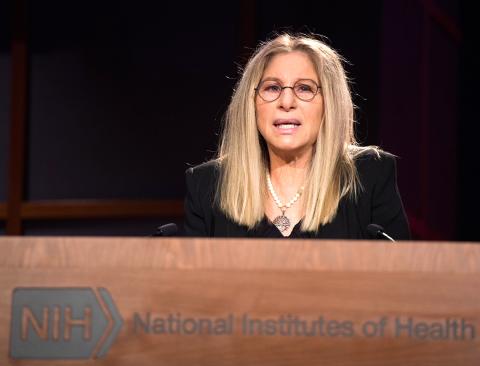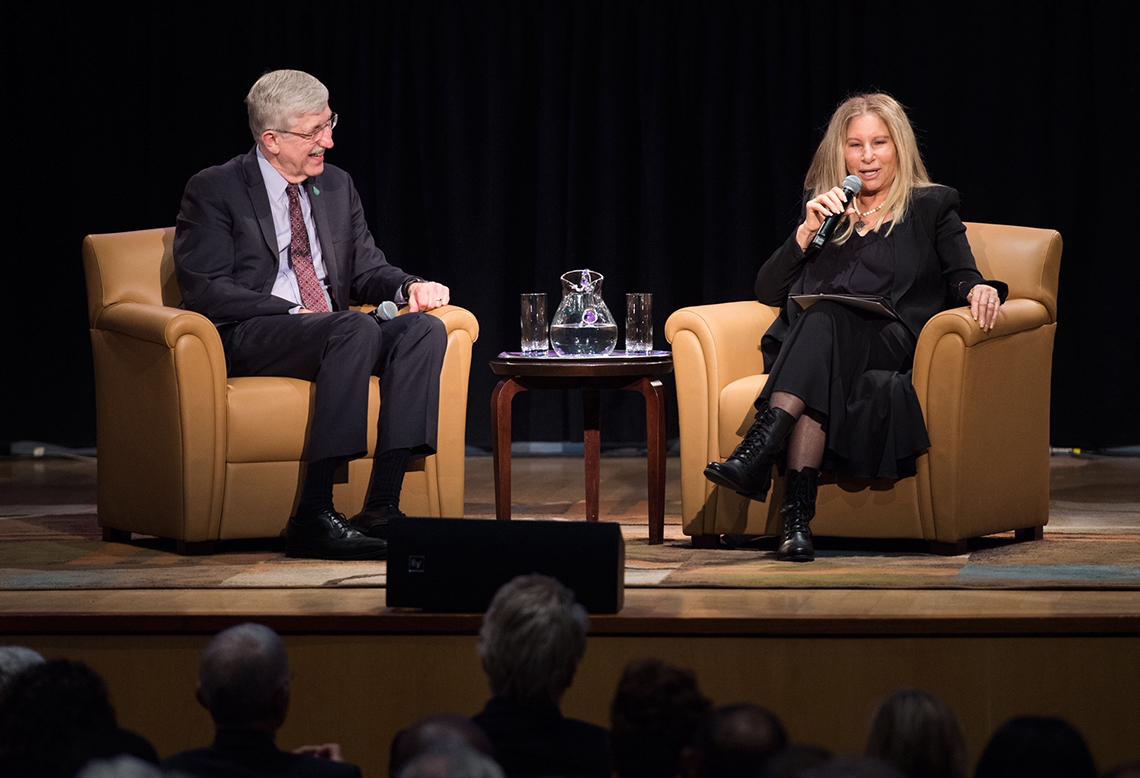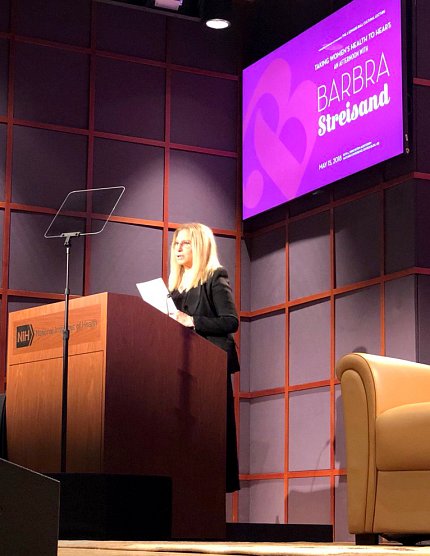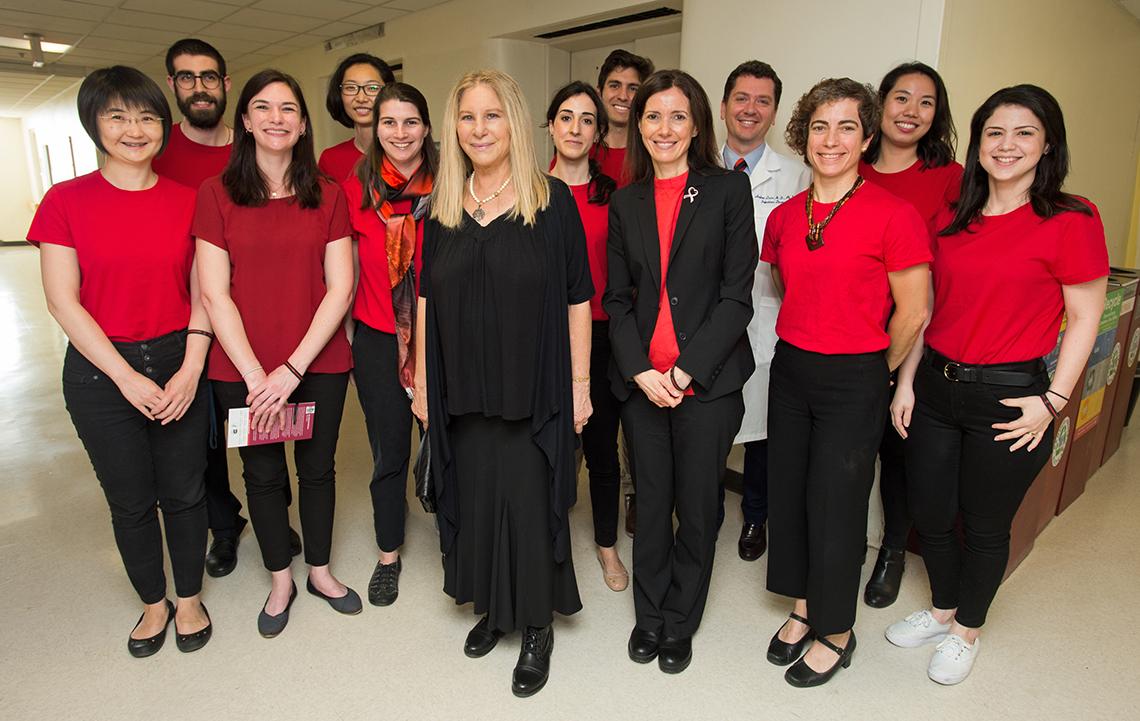Artist, Scientists, Soulmates
Streisand Delivers Rall Cultural Lecture

Photo: Women's Heart Alliance
Barbra Streisand isn’t a doctor, although she has played one on screen. She’s graced stages big and small across the globe, from Hollywood and Broadway to London and Sydney. At NIH on May 15, the world- renowned singer-actor-director used her voice in a less-familiar venue to amplify a topic that’s been close to her heart throughout her six-decade career: gender equity, especially in science and health.
“The closest thing I have to a medical credential is my role in What’s Up, Doc?,” Streisand joked as she began her remarks at the J. Edward Rall Cultural Lecture.
Focusing on women’s health and underrepresentation of women in medical research, the event—“Taking Women’s Health to Heart: An Afternoon with Barbra Streisand”—later featured a conversation with NIH director Dr. Francis Collins, who introduced her.
“We are blessed indeed to have with us such a remarkable leader in the arts, but also in the promotion of human medicine and the need to focus on women’s health,” Collins said.
Addressing a packed Kirschstein Auditorium in the Natcher Bldg., Streisand drew parallels between NIH’s expertise and her own.
“The Rall lecture is a recognition that scientists and artists have much in common,” she said. “We’re both obsessed with the quest for beauty, understanding and truth. We’re both seeking answers to the big questions about causes and consequences, hows and whys, origins and endings, life and death. We both see magic in the smallest details—a film cell or a stem cell.”
Pointing out that genius artists Michelangelo and Leonardo DaVinci were both known to also study anatomy, Streisand said, “[Likewise] brilliant scientists have turned to the arts and culture for inspiration.”
As examples, she mentioned Einstein and his violin as well as two of NIH’s own—Collins and his guitar and campus legend (and fellow Brooklyn, N.Y. native) the late Dr. Ruth Kirschstein, who trained as a classical pianist before concentrating on a career in biomedical research.
“Most of all, what links our two communities is the focus on what it means to be human,” Streisand emphasized. “Our life’s work, our passion is in improving and uplifting humanity. So it’s no accident that you see such mutual respect across our fields.”
Streisand’s lifelong advocacy for social issues and her philanthropy are well-documented. In 1986, she formalized such efforts by establishing the non-profit Barbra Streisand Foundation, which funds grants on diverse issues from civil, human and women’s rights to global climate change.
The Yentl Syndrome
Several years before that, though, after deciding to write, direct, produce and star in the film Yentl, Streisand came face to face with the issue of gender inequality.

Photo: Women's Heart Alliance
She said she experienced both overt and subtle discrimination “in a big way.” Hollywood heavyweights weren’t convinced that a woman director—even an experienced “so-called bankable star” such as Streisand—could handle a movie budget or bring a film vision to profitable reality. Would an audience even appreciate the story of a bookish young Jewish girl who masquerades as a boy in order to get an education?
“Running into this kind of bias was a life-changing moment for me,” she recalled. “But I couldn’t give up. More important it mobilized my commitment to women’s equality. I became passionate about trying to ensure that women get the same chances in life as men.”
Secondhand Woes, Unique Symptoms
Several years later, Streisand was intrigued when she heard about a New England Journal of Medicine article written in 1991 by then NIH director Dr. Bernadine Healy.
A cardiologist, Healy presented evidence of what she called “The Yentl Syndrome”—disparities in diagnosis and treatment of women with cardiovascular disease versus men with the ailment.
Unless women showed the same signs of CVD that characterized the disorder in men, females were often turned away from the emergency room, their own unique symptoms misdiagnosed and under-treated.
“The more I learned about women’s heart health, the more astonished and upset I became,” Streisand said. “For much too long, CVD has been perceived as a man’s disease—not only from the patient’s point of view but also in the way it’s been treated and studied…Most of the research has been conducted primarily on men, right down to male mice in the lab. Most treatments and therapies were tested on men. Sex-specific differences have been neglected all the way from the lab to the ER—even though women’s bodies and biology are so different.”
Such realities led the rare EGOT (winner of all four of entertainment’s biggest awards—Emmy, Grammy, Oscar and Tony) to get involved with the Women’s Heart Center at Cedars-Sinai in Los Angeles, which “focuses on identifying female-patterned heart disease.” She established the Barbra Streisand Women’s Heart Center there in 2012.
“I wanted to raise women’s awareness of heart disease and drive policy change at every level,” she said.
‘Women’s Hearts, Everyone’s Minds’
In 2014, Streisand cofounded the Women’s Heart Alliance, whose mission is to advocate and fund research and treatments on gender differences in CVD.

Photo: Women's Heart Alliance
“We want to make sure women’s hearts are on everyone’s minds,” Streisand emphasized.
That quest brought her and several of the Alliance’s top leaders to NIH, which she thanked “for being a great partner in research,” particularly on the 21st Century Cures legislation that her Alliance championed to look at sex differences in biomedicine.
Streisand also acknowledged NIAID director Dr. Anthony Fauci and the REPRIEVE trial as an example of leadership in that regard. She and Fauci had teamed up in 2016 to write a Health Affairs article about inclusion and gender equity in research.
“In order for science and art together to have their greatest impact on society,” the filmmaker said, “we need to ensure that all people are included as creators and as subjects. We need everyone’s perspective at the table, at the bench, in the studio and in the lab. We need everybody’s stories reflected in our research, in our studies, on our stages and on our screens.”
Streisand concluded with words of encouragement for all NIH’ers: “My wish for all of you is that your work will make history that shapes a future where all men and women can live their best possible lives…Keep searching for beauty in every cell.”
After her talk, the only recording artist to have number one albums in six consecutive decades sat down with Collins for an open chat on stage, where they discussed several topics from the personal (her early childhood realization of gender differences when she attended shul with her grandfather) to the professional (how the art of storytelling can effectively raise awareness about health issues such as CVD). A lab tour (see sidebar) in the Clinical Center followed the chat.
“I want to thank you for the way in which, by being here, you inspire us,” Collins said, giving Streisand an NIH “National Institutes of Hope” pin. “By the way in which you’re leading your life you inspire us, by the way in which your gifts in music, in filmmaking have blessed generations…You give us hope by the way in which you’ve conducted yourself…We think of ourselves as the ‘National Institutes of Hope’ and by being here you’ve taken our hope up a notch.”
View the archived lecture online at https://videocast.nih.gov/summary.asp?Live=27824&bhcp=1.

